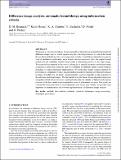Files in this item
Difference image analysis : automatic kernel design using information criteria
Item metadata
| dc.contributor.author | Bramich, D. M. | |
| dc.contributor.author | Horne, Keith Douglas | |
| dc.contributor.author | Alsubai, K. A. | |
| dc.contributor.author | Bachelet, E. | |
| dc.contributor.author | Mislis, D. | |
| dc.contributor.author | Parley, N. | |
| dc.date.accessioned | 2016-03-28T12:00:14Z | |
| dc.date.available | 2016-03-28T12:00:14Z | |
| dc.date.issued | 2016-03-21 | |
| dc.identifier | 241589050 | |
| dc.identifier | 99bbc7a7-02a9-4c67-84de-62c5ea967398 | |
| dc.identifier | 84961584135 | |
| dc.identifier | 000372599600040 | |
| dc.identifier.citation | Bramich , D M , Horne , K D , Alsubai , K A , Bachelet , E , Mislis , D & Parley , N 2016 , ' Difference image analysis : automatic kernel design using information criteria ' , Monthly Notices of the Royal Astronomical Society , vol. 457 , no. 1 , pp. 542-574 . https://doi.org/10.1093/mnras/stv2910 | en |
| dc.identifier.issn | 0035-8711 | |
| dc.identifier.other | RIS: urn:E4CD9EFF425B6ECE6B124BF481CD22DB | |
| dc.identifier.uri | https://hdl.handle.net/10023/8503 | |
| dc.description | This publication was made possible by NPRP grant # X-019-1-006 from the Qatar National Research Fund (a member of Qatar Foundation). | en |
| dc.description.abstract | We present a selection of methods for automatically constructing an optimal kernel model for difference image analysis which require very few external parameters to control the kernel design. Each method consists of two components; namely, a kernel design algorithm to generate a set of candidate kernel models, and a model selection criterion to select the simplest kernel model from the candidate models that provides a sufficiently good fit to the target image. We restricted our attention to the case of solving for a spatially invariant convolution kernel composed of delta basis functions, and we considered 19 different kernel solution methods including six employing kernel regularization. We tested these kernel solution methods by performing a comprehensive set of image simulations and investigating how their performance in terms of model error, fit quality, and photometric accuracy depends on the properties of the reference and target images. We find that the irregular kernel design algorithm employing unregularized delta basis functions, combined with either the Akaike or Takeuchi information criterion, is the best kernel solution method in terms of photometric accuracy. Our results are validated by tests performed on two independent sets of real data. Finally, we provide some important recommendations for software implementations of difference image analysis. | |
| dc.format.extent | 33 | |
| dc.format.extent | 31622094 | |
| dc.language.iso | eng | |
| dc.relation.ispartof | Monthly Notices of the Royal Astronomical Society | en |
| dc.subject | Methods: data analysis | en |
| dc.subject | Methods: statistical | en |
| dc.subject | Techniques: image processing | en |
| dc.subject | Techniques: photometric | en |
| dc.subject | QB Astronomy | en |
| dc.subject | QC Physics | en |
| dc.subject | NDAS | en |
| dc.subject.lcc | QB | en |
| dc.subject.lcc | QC | en |
| dc.title | Difference image analysis : automatic kernel design using information criteria | en |
| dc.type | Journal article | en |
| dc.contributor.sponsor | Science & Technology Facilities Council | en |
| dc.contributor.institution | University of St Andrews. School of Physics and Astronomy | en |
| dc.identifier.doi | 10.1093/mnras/stv2910 | |
| dc.description.status | Peer reviewed | en |
| dc.identifier.grantnumber | ST/M001296/1 | en |
This item appears in the following Collection(s)
Items in the St Andrews Research Repository are protected by copyright, with all rights reserved, unless otherwise indicated.

